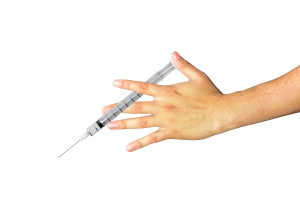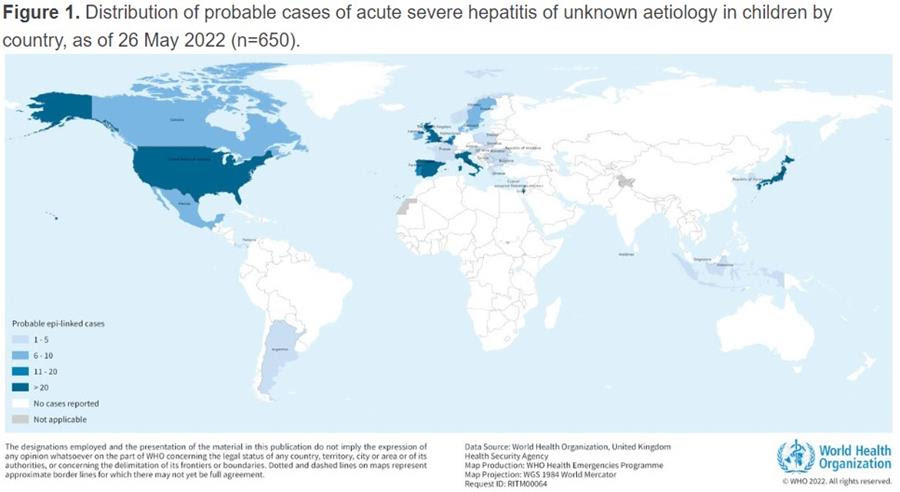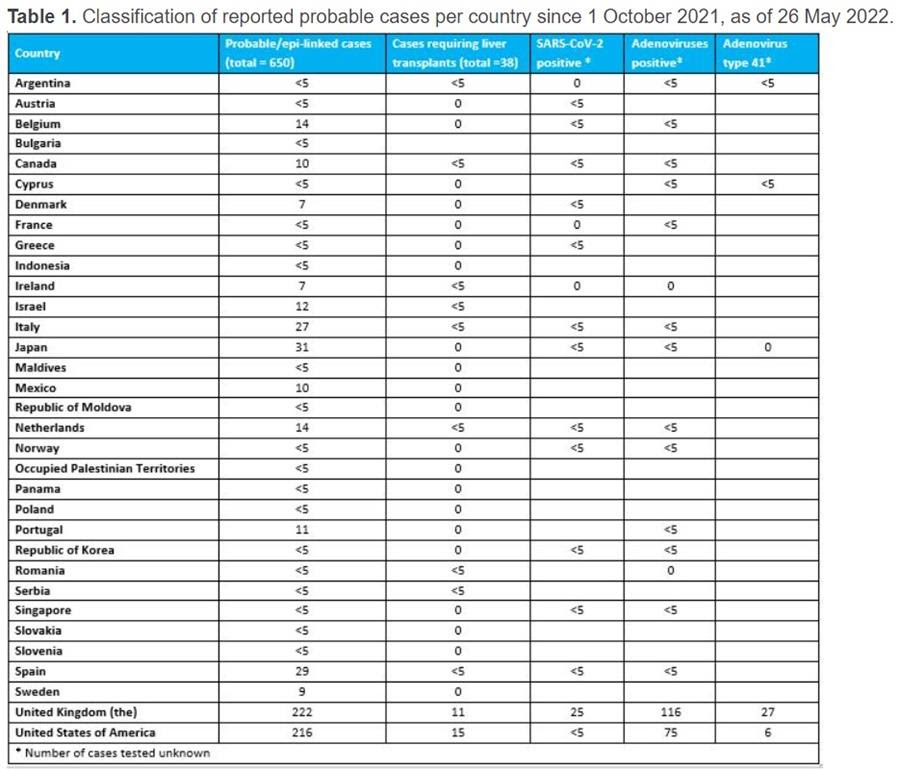
Disease Outbreak News
Geneva: Six hundred and fifty probable cases of acute hepatitis of unknown aetiology in children have been reported to the World Health Organization (WHO) from 33 countries between April 5 and May 26, 2022, with 99 additional cases pending classification.
The majority of reported cases (n=374; 58%) are from the WHO European Region (22 countries), with 222 (34%) cases from the United Kingdom of Great Britain and Northern Ireland alone. Probable cases and cases pending classification have also been reported from the Region of the Americas (n=240, including 216 cases in the United States of America), Western Pacific Region (n=34), the South-East Asia Region (n=14) and Eastern Mediterranean Region (n=5) (Figure 1, Table 1).
The aetiology of this severe acute hepatitis remains unknown and under investigation; the cases are more clinically severe and a higher proportion develops acute liver failure compared with previous reports of acute hepatitis of unknown aetiology in children. It remains to be established whether and where the detected cases are above-expected baseline levels. WHO assesses the risk at the global level as moderate.


Out of the 650 probable cases, at least 38 (6%) children have required transplants, and nine (1%) deaths have been reported to WHO.
According to the latest Joint Surveillance Report by the WHO Regional Office for Europe (EURO) and the European Centre for Disease Prevention and Control (ECDC) on cases from EU/EEA countries which have been reported through the European Surveillance System (TESSy), as of May 20, 2022:
- Three quarters (75.4%) of cases are <5 years of age.
- Of 156 cases with information on hospital admission, 22 (14.1%) were admitted to an intensive care unit. Of the 117 cases for which this information was available, 14 (12%) have received a liver transplant.
- Overall, 181 cases were tested for adenovirus by any specimen type, of which 110 (60.8%) tested positive. The positivity rate was the highest in whole blood specimens (69.5%).
- Of the 188 cases PCR tested for SARS-CoV-2, 23 (12.2%) tested positive. Serology results for SARS-CoV-2 were only available for 26 cases, of which 19 (73.1%) had a positive finding.
- Of the 63 cases with data on COVID-19 vaccination, 53 (84.1%) were unvaccinated.
Most of the reported cases appear to be unrelated and extensive epidemiological investigations are underway to identify common exposures, risk factors or links between cases. Two pairs of cases have been reported as epidemiologically linked in Scotland, and linked cases have also been reported in the Netherlands.
Based on the working case definition for probable cases, laboratory testing has excluded hepatitis A-E viruses in these children. SARS-CoV-2 and/or adenovirus have been detected in a number of the cases, although the data reported to WHO is incomplete. The United Kingdom has recently observed an increase in adenovirus activity, which is co-circulating with SARS-CoV-2, though the role of these viruses in the pathogenesis is not yet clear.
Further detailed epidemiological, clinical, laboratory, histopathological and toxicological investigations of the possible cause(s) of these cases are underway by several national authorities, research networks and across different working groups in WHO and with partners. Additional investigations are also planned to ascertain whether and where the detected cases are above-expected baseline levels.
WHO said clinical and public health incident responses have been activated across the affected regions to coordinate case finding with the investigation into the cause of illness in these children.
Further investigations by various national authorities are ongoing to include more detailed exposure histories, toxicology testing, and additional virological/microbiological tests.
WHO risk assessment
WHO assesses the risk at the global level as moderate considering that:
- The aetiology of this severe acute hepatitis remains unknown and under investigation; the cases are more clinically severe and a higher proportion develops acute liver failure compared with previous reports of acute hepatitis of unknown aetiology in children;
- Limited epidemiological, laboratory, histopathological and clinical information is currently available to WHO;
- The actual number of cases may be underestimated in some settings, in part due to the limited surveillance capacity in place;
- The source and mode of transmission of the potential aetiologic agent(s) has not yet been determined, and so the likelihood of further spread cannot be fully assessed;
- Although there are no available reports of healthcare-associated infections, human-to-human transmission cannot be ruled out as there have been a few reports of epidemiologically linked cases.
Adenovirus has been found in 75% of the cases tested in the United Kingdom, but the data for other countries are incomplete. Of the small number of samples that have so far been typed, a majority have been confirmed for Type 41 adenovirus (in the United Kingdom, in 27 of 35 cases with an available result). Adenovirus associated virus 2 (AAV-2) has also been detected in a small number of cases in the United Kingdom using meta-genomics in liver and blood samples.
However, many of the remaining cases did not have appropriate samples taken, highlighting the importance of appropriate sampling (whole blood) to further characterize the type of adenovirus detected. Additionally, Type 41 adenovirus infection has not previously been linked to such a clinical presentation in otherwise healthy children.
While adenovirus is a plausible hypothesis as part of the pathogenesis mechanism, further investigations are ongoing for the causative agent; adenovirus infection (which generally causes mild self-limiting gastrointestinal or respiratory infections in young children) does not fully explain the more severe clinical picture observed with these cases. Factors such as increased susceptibility amongst young children following a lower level of circulation of adenovirus during the COVID-19 pandemic, the potential emergence of a novel adenovirus, SARS-CoV-2 co-infection or a complication of previous SARS-CoV-2 infection, leading to superantigen-mediated immune cell activation, proposed a causal mechanism of the multisystem inflammatory syndrome in children need to be further investigated. Hypotheses related to side effects from COVID-19 vaccines are currently not supported as most of the affected children did not receive these vaccines. Other infectious and non-infectious explanations as independent or contributory factors need to be excluded to fully assess and manage the risk.
It is important to note that the current apparent association identified with adenovirus could be an incidental finding due to enhanced laboratory testing in association with increased levels of community transmission of adenovirus. This will be further clarified with the expansion of adenovirus testing to other cases beyond Europe and the United States, and reporting of the findings from the UKHSA case-control study currently underway.
The absence of a confirmed aetiology poses additional challenges in some countries, including implementation of WHO’s case definition and further diagnostic exclusion, due to limited testing capacity, including for Hepatitis A-E viruses and adenovirus. The presence of cases of acute hepatitis in children cannot be ruled out in countries where cases have not been detected or reported yet, but it is unlikely that symptomatic and severely ill case-patients requiring hospitalization would remain undetected.
For the prevention of adenovirus and other common infections, the WHO advises performing regular hand washing and respiratory hygiene.
In children with acute hepatitis, the main concern is to identify cases early to ensure optimal case management and to determine the cause, since management and control measures and capacities will depend on the specific causative agent. While most countries have the capacity for medical treatment of acute hepatitis, this is not true for liver transplantation capacity or for intensive support and care for liver failure.
WHO said it is closely monitoring the situation and supporting international coordination working with the Member States and partners.
– global bihari bureau





